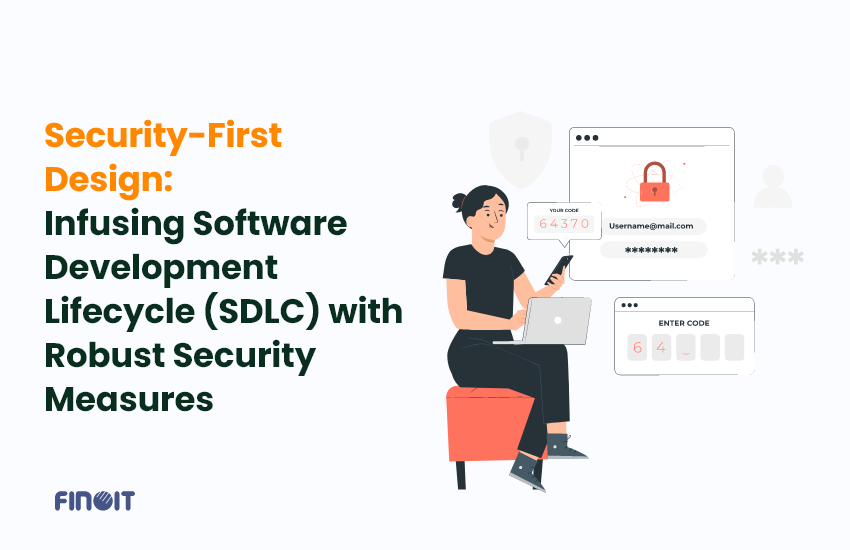Security-First Design: Infusing Software Development Lifecycle (SDLC) with Robust Security Measures

Crime has a new face today; what earlier was a threat to human life through weapons is now done through data. Businesses are becoming highly susceptible to these attacks, also affecting them financially. You would be surprised to know the global average cost of a data breach in 2023 was USD 4.45 million, a 15% increase over three years. Says a report by IBM.
Undeniably, the consequence of security breaches can be devastating for any application or business. But is there a way to prevent these attacks?
Well, if not entirely, a protective shield can be adopted right from designing the software development life cycle to guard your application. In addition to protection against vulnerabilities and cyber threats, a secured system architecture provides other benefits, which we will discuss as the article proceeds.
Importance of Integrating Security in Software Development Lifecycle
As cyber breaches become more sophisticated and frequent, it’s crucial to have a security architecture in place right from the development process to safeguard your digital assets. But what exactly does security architecture mean, and why should your organization invest in it?
In simple terms, a security architecture framework is a set of principles and guidelines that help you implement security measures across different levels of your business. There are various international framework standards available, each designed to solve a specific problem. Three of the most commonly used security architecture frameworks are:
- The Open Group Architecture Framework (TOGAF)
- Sherwood Applied Business Security Architecture (SABSA)
- Open Security Architecture (OSA)
To protect your most valuable information assets, it’s essential for every custom app development company to have a robust security architecture framework in place. By strengthening your software security and addressing common security vulnerabilities, you can significantly reduce the risk of a cyber attacker succeeding in breaching your systems. There are other benefits of infusing your system architecture with security measures, which are as follows:
Helps develop a Proactive Application Security:
Considering security into your software development is essential as a fundamental aspect of architecture development. By adopting a proactive approach, you can identify potential security risks and take preventive measures at the initial stages of development. This approach is more effective and less costly compared to addressing vulnerabilities later on.
A proactive approach to security involves considering the security requirements, identifying potential threats, and implementing security measures to mitigate those threats. This approach ensures the system’s security at all stages of development and reduces the chances of security breaches.
By incorporating security measures into the foundation of architecture development, you can ensure a secure SDLC from the beginning. This approach also helps improve the system’s overall performance and reliability, as it is designed with security in mind.
Makes business Cost Efficient:
Implementing robust security measures within your system architecture can significantly enhance your business’s cost efficiency:
- Reduced Risk of Breaches and Incidents: By integrating strong security measures from the start, you minimize the risk of data breaches and cyber-attacks. This proactive approach helps you avoid the substantial costs associated with addressing and recovering from such incidents, including legal fees, customer compensation, and damage to your reputation.
- Avoidance of Remediation Costs: Retrofitting secure codes into an existing system often demands extensive remediation efforts, including identifying vulnerabilities and patching systems. Embedding security from the beginning can bypass these costly and time-consuming processes.
- Regulatory Compliance and Penalties: Many industries face strict data protection and privacy regulations. Designing your system with compliance in mind reduces the risk of violations, saving you from potential fines and penalties.
- Operational Efficiency: A secure architecture reduces the chances of downtime due to security incidents. This uninterrupted workflow enhances productivity and saves costs associated with system interruptions.
- Resource Allocation: Investing in robust application security best practices early in the architecture design phase allows you to allocate resources more efficiently. It prevents the need for substantial investments later to rectify security flaws, enabling you to focus resources on innovation and growth.
- Reduced Insurance Premiums: Insurance companies often consider the level of security measures implemented when determining premiums for cybersecurity insurance. A system with robust security architecture may lead to lower insurance costs, reducing overall expenses.
Helps in Mitigating Potential Risks:
Designing a system with security issues in mind minimizes the chances of leaving loopholes or weaknesses that hackers could exploit for every software product engineering company. This approach ensures that security measures are embedded throughout the system, reducing potential vulnerabilities in several ways as follows:
- Proactive Identification of Vulnerabilities:
Integrating security measures during the architecture phase allows for the early identification of potential vulnerabilities. It also helps you identify and mitigate security risks before they become significant threats.
- Prevention of Exploitation:
By embedding security protocols and measures from the beginning, you create a fortified defense against potential cyber threats. This reduces the likelihood of vulnerabilities being exploited by attackers seeking to breach your system.
- Risk Reduction through Defense Layers:
A well-designed architecture that undergoes layered security testing incorporates defense-in-depth strategies, employing multiple layers of security controls. These layers work collectively to mitigate risks. Even if one layer is breached, others provide additional protection, reducing the overall risk of a successful attack.
- Adherence to Best Practices:
Infusing security into architecture ensures compliance with industry best practices and security standards. This alignment reduces the chances of overlooking essential security measures, thus mitigating risks associated with non-compliance and oversight.
- Improved Incident Response:
A system with security ingrained into its architecture often includes well-defined incident response plans. This preparedness allows for swift and effective responses to security incidents, minimizing the impact and reducing the associated risks.
- Continuous Monitoring and Adaptation:
Security-infused architecture often includes robust monitoring tools that continuously monitor the system for anomalies and potential threats. This proactive monitoring techniques, like penetration testing enable the system to adapt and respond to emerging risks promptly.
- Safeguarding Sensitive Data:
Integrated security measures help protect sensitive data from unauthorized access or breaches. Encrypting data, implementing access controls, and securing communication channels contribute to mitigating risks associated with data exposure or theft.
- Resilience to Evolving Threats:
A security-focused architecture is designed to adapt to new threats and evolving attack vectors. It allows for the incorporation of new security technologies and practices, ensuring the system’s resilience against emerging risks.
Enhances Trust and Compliance:
Integrating security from the ground zero increases trust among users, stakeholders, and regulatory bodies. It demonstrates a commitment to security and compliance with industry standards and regulations in the following ways:
- Building User Trust:
A secure software development process demonstrates a commitment to safeguarding user data and sensitive information. When users trust that their data is protected, it fosters a sense of confidence and reliability in your services or products.
- Protecting Confidentiality and Privacy:
Robust security measures integrated into your system architecture safeguard confidentiality and privacy. This protection of sensitive data builds trust among users, assuring them that their personal information is handled with the utmost care and security.
- Meeting Regulatory Requirements:
Compliance with industry-specific regulations and data protection laws is crucial. Infusing security into the software development procedure ensures alignment with these regulations, minimizing the risk of penalties or legal issues due to non-compliance. This compliance instills confidence among stakeholders and users about your application’s commitment to following legal standards.
- Enhancing Transparency:
Build secure system that includes transparent security practices regarding how security measures are implemented and maintained can enhance trust among users, stakeholders, and regulatory bodies by showcasing a clear dedication to security.
- Supporting Business Partnerships:
Businesses often collaborate and form partnerships. A robust security architecture is a significant asset when seeking partnerships. It demonstrates reliability, compliance with standards, and a commitment to data protection, fostering trust among potential partners.
- Mitigating Risks of Breaches and Data Loss:
A secure architecture minimizes the risks associated with data breaches or loss. This reduced risk enhances trust among users and stakeholders by assuring them that their information is safe and protected within your system.
- Maintaining Reputation and Brand Imag
A security breach can severely damage an organization’s reputation. By infusing security measures into the architecture, businesses safeguard their brand image and maintain a positive reputation, bolstering trust among existing and potential customers.
- Encouraging Customer Loyalty:
When users feel confident in the security of their data, they are more likely to remain loyal to a platform or service. A secure system architecture contributes to a positive user experience, fostering customer loyalty and retention.
Fosters Adaptability and Scalability:
Security measures embedded early in the architecture can adapt and evolve as the system grows. This scalability allows for easier integration of new security protocols or technologies without significant disruptions in the following ways:
- Facilitating Agile Adaptation to New Technologies:
A secure architecture is inherently designed to accommodate new technologies and evolving security measures. This adaptability allows for the seamless integration of emerging security protocols and updates without compromising the overall system’s stability.
- Supporting Flexible Business Growth:
Security-focused architectures are often designed with scalability in mind. As your business expands, a secure foundation enables smooth scaling without compromising security. It allows for the addition of new components or modules while ensuring they adhere to established security standards.
- Ease of System Integration:
Security-centric architectures promote modularity and interoperability. This makes it easier to integrate new systems or components while ensuring that security measures remain intact and consistently applied across the entire infrastructure.
- Adapting to Changing Threat Landscapes:
A secured system architecture is proactive in addressing evolving cyber threats. It allows for implementing new security features and adjustments to counter emerging threats, ensuring continued protection against evolving risks.
- Efficient Resource Allocation:
Secure architectures enable more efficient resource allocation, allowing for the prioritization of security needs alongside other business requirements. This adaptability ensures that resources are appropriately allocated to maintain a robust security posture while supporting business objectives.
- Enhancing System Resilience:
A secure architecture’s adaptability enhances the system’s resilience against potential disruptions. It allows for incorporating redundancy, fail-safes, and backup mechanisms to ensure continuity even in the face of security incidents or attempted breaches.
- Enabling Rapid Response to Security Incidents:
Systems designed with security in mind often include provisions for rapid response to security incidents. This adaptability ensures swift actions and adjustments to mitigate risks or contain potential breaches effectively.
- Scalability Without Compromising Security:
As your system expands, a secure architecture ensures that security measures can scale alongside the growth. This scalability doesn’t compromise the system’s security integrity, maintaining protection levels even in larger, more complex infrastructures.
Reduces Downtime and Disruption:
An architecture that prioritizes security from the outset is less likely to suffer major breaches or vulnerabilities that could cause downtime or disrupt services. This stability is essential for maintaining operations and reducing downtime and disruptions through the following mechanisms:
- Preventing Security Breaches and Incidents:
By integrating robust security measures, a secure architecture minimizes the risk of security breaches and cyber incidents. This proactive approach prevents potential attacks or unauthorized access attempts, reducing the likelihood of system downtime caused by security breaches.
- Early Detection and Mitigation of Threats:
Secure architectures often incorporate advanced monitoring and detection systems. These systems continuously monitor the network for anomalies and potential threats. Early detection enables swift mitigation, preventing threats from escalating and causing system disruptions.
- Enhanced Resilience to Attacks:
A system with strong security protocols and measures is inherently more resilient to attacks. Even in the event of an attempted breach, the layered security approach inherent in a secure architecture mitigates the impact and minimizes disruptions to system operations.
- Streamlined Incident Response:
Secure architectures often include well-defined incident response plans. These plans enable prompt and efficient responses to security incidents. Quick and effective incident response reduces the duration of potential disruptions, limiting the impact on system availability.
- Continuous Availability and Uptime:
Security-focused architectures emphasize maintaining continuous availability. They incorporate redundancy, failover mechanisms, and load balancing techniques to ensure that services remain accessible even during security events or maintenance activities, reducing downtime.
- Reduced System Patching Downtime:
A system designed with security in mind often requires fewer urgent patches or fixes due to vulnerabilities. This reduces the need for frequent system downtime to apply emergency security updates, ensuring continuous system availability.
- Prevention of Data Loss or Corruption:
Security measures within the architecture safeguard against data loss or corruption caused by security incidents. Protecting critical data assets minimizes disruptions due to data loss or corruption.
- Building a Resilient Infrastructure:
A focus on security often involves building a resilient infrastructure with fail-safes and backup mechanisms. This infrastructure resilience ensures that even if one component is compromised, the system as a whole remains operational, reducing the overall impact of potential disruptions.
Conclusion:
As technology continues to advance and our world becomes more interconnected, the risk of cyber attacks and security breaches also increases. In order to protect your systems and data from potential threats, it’s crucial to incorporate security measures into the very architecture of these systems. Doing so isn’t just a best practice, it’s essential for building resilient systems that can withstand even the most sophisticated attacks.
By integrating security into the foundation of our digital infrastructure, you can stay one step ahead of the evolving threat landscape and ensure that our sensitive information remains safe and secure.
Finoit can help you develop a security first system design, to know how get in touch with the cyber security specialists today.


